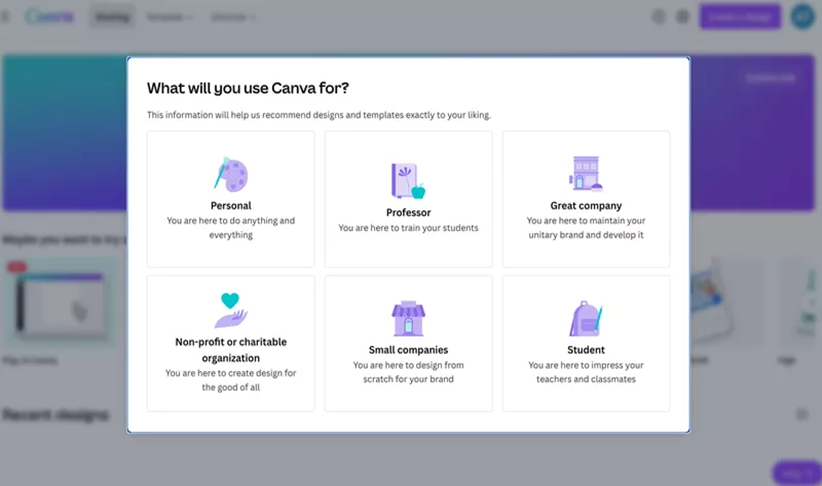We’ve made some enhancements to our self-service offering and we’re convinced that intent-based onboarding will be a leading conduit to the successful first time user experience. This post is to share more about what we did, why, and some lessons learned along the way!
Great onboarding flows orient around outcomes
A key goal at Banyan is to guide organizations on their journey toward securing a modern, hybrid workforce. “Journey” is the most important word in that statement. In hundreds of conversations with customers and prospects, we’ve seen that organizations ultimately agree on an end state but they are at a variety of stages along the way.
We’ve found that orienting the user around the outcome they want to achieve at the start of onboarding will lead to an optimal experience and higher conversion.

Let’s take the three main personas we encounter evaluating our Zero Trust Networks Access (ZTNA) offering.
Networking teams are looking for a modern VPN solution that accomplishes the following:
- Better performance. And even the ability to own and manage their own points of presence
- Device trust that integrates with their existing security investments and provides continuous evaluation
- Easy to configure policies with a streamlined end user experience
Security and Compliance teams are aiming to reduce reliance on the VPN and accomplish the following:
- Publish granular, least privileged access to private resources such as databases, internal websites, Linux servers, and more
- Establishing different baseline trust profiles for employees, contractors, and vendors
- Add device trust and passwordless to SaaS applications without IP whitelisting
Devops teams are having a field day with the automation capabilities that ZTNA and SSE (Security Service Edge) vendors provide. They are increasingly looking for:
- Automation via “zero trust as code”
- Strong access policies, audit logging, and monitoring to infrastructure such as SSH servers and Kubernetes clusters
We’ve built a personalized, intent-based onboarding flow to account for the goals these teams have and the early results are promising.
Why we love intent-based onboarding
A benefit of layering on a bottoms up, product-led growth motion is that users are often signing up with a specific problem already in mind. Their intent is to see if your product solves that problem and provides them a stellar experience along the way. Building your onboarding flow to account for this has many benefits.
- It helps personalize the experience. Canva asks users how they will use the tool in order to cater a series of templates for them.

- It allows you to quantify the outcomes that are most important to your user base. Based on this data, you can iterate quickly and ensure you are providing enough value to have an active, monetizable user base.

More self-service learnings and insights
Effective onboarding is emotional
The beauty and challenge with self-service is instilling joy in signing up for and configuring a product. This is where the lines between consumer products and B2B products start to blur. It’s also a test of which organizations really understand their users and the types of products they love.

I wouldn’t go as far as saying onboarding onto Banyan’s security offering should be equivalent to signing up for TikTok but there are two key learnings thus far:
- Users want to feel progress as they navigate their onboarding. Small wins add up to a larger win or ‘aha’ moment. For example, this could be a dashboard updating in real-time or even providing test connection buttons to successfully show a component is connected.
- Education and context is key. The user must understand the context of the step they are on but also WHY the step is needed to accomplish their broader goal. Investing in this area will result in product stickiness as well as a savvy user base.
Remove dependencies on other teams
Often, setting up a security solution requires talking to multiple groups within an organization. The infrastructure team may need to be involved to set up a server and add firewall rules. The identity team may be required to set up users and groups. If a self-serve offering requires this much interaction, it will strongly impact activation metrics and user sentiment. You want to get users to their ‘aha’ moment as quickly as possible.
At Banyan, we sought out a design that would eliminate many cross-functional dependencies within teams while prioritizing context and user education. When you sign up for the product, we provide local user management and default to our Global Edge deployment model which eliminates the need to open inbound ports or change firewall rules. This is the fastest way to get going with the product and allows a frictionless first time user experience.

The Banyan team in a workshop to design the enhanced onboarding flow!
Every step must build on the next
When we started building a self-service offering, we had many conversations on the most streamlined way to get to the ‘aha’ moment. I suspect this is common with most organizations venturing into self-service. However, we became obsessed with removing dependencies! Can the user see the value without having to set up infrastructure? Do they need to download an app?
The danger in this approach is that you can end up building around friction points and ultimately miss creating any stickiness within the product. Every action a user takes in the product should build towards the outcome they are looking for. Address key friction points head on as the payoff is exponential for not only a self-serve motion but existing customers as well.
Try it out for free!
The product and engineering teams worked hard to get this first phase of intent-based onboarding out the door so we’d love to hear what you think. All you need is a resource you want to provide secure access to and 15 minutes of time. There’s plenty more to come…
Sign up here!



